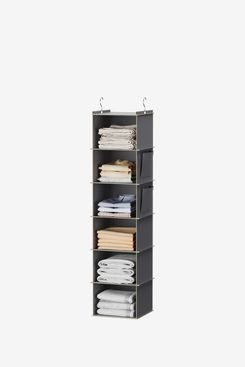
There’s a certain irony in how challenging it can be to keep cleaning agents and tools organized. Ria Safford, a home organizer who has worked with Paris Hilton and Chrissy Teigen, among other celebrities, tackles this problem frequently on the job and has developed strategies for keeping an unwieldy collection of spray bottles, wipe containers, and jugs of detergent in order.
“The biggest mistake people make is getting organizational products before the project has even started,” Safford says. “I’ve had a slew of clients where I show up and they’re like, ‘Oh yeah, I grabbed these bins from Home Goods — they were on sale — and I have this basket.’” Instead of forcing a solution to work with the organizers you have, she recommends finding an organizing solution for the problem you have. It may sound obvious, but for many people, visualizing a new system and letting go of an old one, however malfunctioning it may be, is the biggest hurdle.
Like many professional organizers, Safford says to start with editing. Assess your cleaning supplies, discard or donate what you don’t need, and then group items by category, separating out the specialty cleaners from the bathroom supplies and so on. Then choose the right storage solutions — and the right spaces for them. “A common thing clients will do is say, ‘All my cleaning products live under the kitchen sink.’ But there’s really no reason that toilet-bowl cleaner should be under the sink in your kitchen,” she points out.
Below are Safford’s tips for corralling the Lysol and the Clorox, keeping sponges accessible but out of sight, and turning previously unused spaces into storage for vacuum attachments, mops, and brooms.
“Cleaning supplies are often stored in out-of-sight places like laundry cabinets or under the sink, which makes it easy to continue to place items without a plan,” Safford says. Clear storage bins can help to create order and set limits.
To keep cabinets, including the space under the sink, from becoming a black hole that cleaning supplies enter, never to be seen again, Safford recommends using a combination of bins and specialty organizers, like this lazy Susan, that make getting to your cleaning products easy. “There should never be more than one step” to retrieve what you need, she says, “maybe two if you’re having to slide a basket aside to reach products stored on a lazy Susan in the back of a deep cabinet.”
To get cleaning products out from under the sink entirely, Safford chose this sturdy over-the-door organizer for heavy items like jugs or tubs of laundry detergent, containers of premoistened surface wipes, and bottles of all-purpose cleaner.
“Tension-rod organizers are easily changeable and allow me to really play around with the space to find a solution that works the best,” says Safford. Using no-damage shelves to create extra storage is the way to go for renters, people who lack confidence in the face of power tools, and, like Safford, those who are prone to fiddling.
Storing your dish sponge in a caddy that attaches to the back of the cabinet door under the sink keeps it in reach, uses an often underutilized space, and helps your sink area look less cluttered. This particular caddy allows sponges and brushes to dry thoroughly.
“A mistake people make is not taking into account the accessibility of these items,” Stafford says of our mops, brooms, and long-handled dusters. Wall-mounted holders let you quickly grab (and put away) those essential cleaning tools and can be installed without nails or screws.
For homes with multiple levels or many rooms, Safford, a Command brand ambassador, says to use caddies “to create cleaning stations in different areas of the home” and reduce the time and energy spent schlepping supplies back and forth.
In small homes that lack storage space, use a rolling cart for cleaning products — think of it as a utility closet on wheels. In addition to offering a lot of storage with a slim footprint, a rolling cart lets you take supplies along from room to room.
Of vacuum-cleaner attachments, Safford says, “you have to figure out a place for them quickly or you’re going to just lose all of those parts.” She uses a large Command caddy for stashing vacuum parts and also suggests a hanger bag with pockets for holding the roller brush, the hose, and the crevice and soft dusting attachments.
Safford likes a hanging closet organizer for storing bulky but lightweight supplies like paper-towel rolls, microfiber cloths, disposable duster refills, and extra sponges.
Like many home organizers, Safford makes frequent use of her label-maker and says that labeling bins, canisters, and shelves can help train you to put items back where they belong and prevent jumble creep.
The Strategist is designed to surface useful, expert recommendations for things to buy across the vast e-commerce landscape. Every product is independently selected by our team of editors, whom you can read about here. We update links when possible, but note that deals can expire and all prices are subject to change.

















